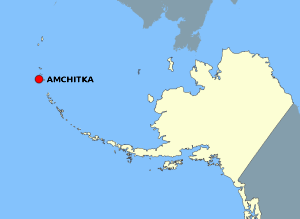Amchitka
| Amchitka Underground Test Site | |
|---|---|

Cannikin warhead being lowered into test shaft
|
|

Location of the site
|
|
| Coordinates | 51°32′32″N 178°59′00″E / 51.54222°N 178.98333°E |
| Type | Nuclear testing range |
| Site information | |
| Operator | United States Department of Energy |
| Status | Inactive |
| Site history | |
| In use | 1965–1971 |
| Test information | |
| Thermonuclear tests | 3 |
| Remediation | 2001–2025 (DoE estimate) |
Amchitka (/æmˈtʃɪtkə/; Aleut: Amchixtax̂) is a volcanic, tectonically unstable island in the Rat Islands group of the Aleutian Islands in southwest Alaska. It is part of the Alaska Maritime National Wildlife Refuge. The island is about 68 kilometers (42 mi) long, and from 3 to 6 km (1.9 to 3.7 mi) wide. The area has a maritime climate, with many storms, and mostly overcast skies.
Amchitka was populated for more than 2,500 years by the Aleut people, but has had no permanent population since 1832. The island has been part of the United States since the Alaska Purchase of 1867. During World War II, it was used as an airfield by US forces in the Aleutian Islands Campaign.
Amchitka was selected by the United States Atomic Energy Commission to be the site for underground detonations of nuclear weapons. Three such tests were carried out: Long Shot, an 80-kiloton (330 TJ) blast in 1965; Milrow, a 1-megaton (4.2 PJ) blast in 1969; and Cannikin in 1971 – at 5 Mt (21 PJ), the largest underground test ever conducted by the United States. The tests were highly controversial, with environmental groups fearing that the Cannikin explosion, in particular, would cause severe earthquakes and tsunamis. Amchitka is no longer used for nuclear testing. It is still monitored for the leakage of radioactive materials.
...
Wikipedia
